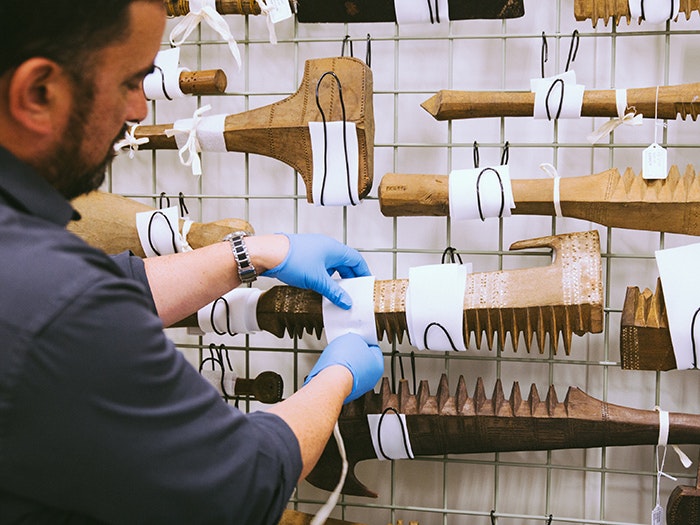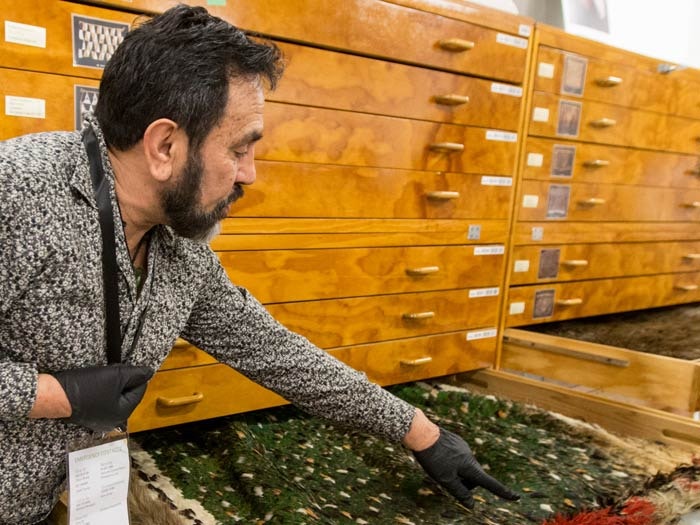
About our Pacific Cultures research
We seek to understand the local and global histories of Pacific peoples, and to document these stories through our collection.
Free museum entry for New Zealanders and people living in New Zealand
Open every day 10am-6pm
(except Christmas Day)
Free museum entry for New Zealanders and people living in New Zealand
Full Tuhinga issue 26 (2.69 MB)
High-res print version - Full Tuhinga issue 26 (27.19 MB)
Or download the individual article you’re interested in below.
Pā in Porirua: social settlements examines the fascinating story of the creation of twelve pā in the Porirua area between 1823 and 1852. It explores who built them and why and gives an insight into this significant period of our early history.
Go to Pā in Porirua: social settlements
H.D. Skinner’s use of associates within the colonial administrative structure of the Cook Islands in the development of Otago Museum’s Cook Islands collections examines the largest collection of Cook Islands objects in New Zealand assembled at Otago Museum by H.D. Skinner during his tenure (1919-57).
Go to H.D. Skinner’s use of associates within the colonial administrative structure of the Cook Islands in the development of Otago Museum’s Cook Islands collections
A silver slice of Māori history: the Te Pahi medal examines how the Te Pahi silver medal, which had been missing for 200 years, suddenly reappeared for auction at Sotheby’s Australia in 2014 and was repatriated to Aotearoa New Zealand through the collaborative efforts of Te Papa and the Auckland Museum.
Go to A silver slice of Māori history: the Te Pahi medal
Re-evaluation of the taxonomic status of Cyathea kermadecensis and C. milnei (Cyatheaceae) supports their continued recognition examines the taxonomic status of two species of tree ferns from the Kermadec Islands, Cyathea kermadecensis and C. milnei (Cyatheaceae), and whether they are distinct enough from their mainland relatives to be considered separate species.
Go to Re-evaluation of the taxonomic status of Cyathea kermadecensis and C. milnei (Cyatheaceae) supports their continued recognition
Pat Stodart
This paper examines the records of 12 pā (fortified settlements) and kāinga (settlements) in use during the Ngāti Toa occupation of Porirua in the 1823–52 period. The histories of each pā and of their major builders are briefly recorded, focusing on the reasons for both the founding and the abandonment of the pā. This information is examined and the conclusion drawn that the creation of these pā was primarily the result of social dynamics. Environmental resources seem to affect the siting of these pā rather than causing their creation. This interpretation may shed some light on why so many pā were built throughout the later part of New Zealand prehistory and the European contact period.
Pā in Porirua: social settlements (589.05 KB)
High-res print version - Pā in Porirua: social settlements (8.61 MB)
Ian Wards
During his tenure at Otago Museum (1919–57), H.D. Skinner assembled the largest Cook Islands collection of any museum in New Zealand. This paper shows that New Zealand’s colonial administrative structure was pivotal in the development of these collections, but that they were also the result of complex human interactions, motivations and emotions.
Through an analysis of Skinner’s written correspondence, examples are discussed that show his ability to establish relationships where objects were donated as expressions of personal friendship to Otago Museum. The structure of the resulting collection is also examined. This draws out Skinner’s personal interest in typological study of adzes and objects made of stone and bone, but also highlights the increasing scarcity of traditional material culture in the Cook Islands by the mid-twentieth century, due in part to the activities of other collectors and museums.
H.D. Skinner’s use of associates within the colonial administrative structure of the Cook Islands in the development of Otago Museum’s Cook Islands collections (239.45 KB)
High-res print version - H.D. Skinner’s use of associates within the colonial administrative structure of the Cook Islands in the development of Otago Museum’s Cook Islands collections (1.82 MB)
Mark Stocker
The sudden reappearance and subsequent sale by Sotheby’s Australia of the Te Pahi medal in April 2014 was a significant numismatic event. The medal is a unique object in early Australasian colonial history. The circumstances of its presentation by the Governor of New South Wales, Philip Gidley King, to Te Pahi, a Ngāpuhi chief, provide insights into colonial and indigenous contacts and relationships in the early 1800s.
This paper considers the circumstances behind the commissioning of the medal in 1805–06 and its disappearance following colonist and whaler raids in 1810. When the medal reappeared, Ngāpuhi demanded its repatriation and attempted to have its sale postponed. Although this proved unsuccessful, the medal was repatriated thanks to a winning bid jointly made by the Museum of New Zealand Te Papa Tongarewa and the Auckland War Memorial Museum Tāmaki Paenga Hira. At the time of writing, the Te Pahi medal has just returned to New Zealand after an absence of more than 200 years.
A silver slice of Māori history: the Te Pahi medal (920.62 KB)
High-res print version – A silver slice of Māori history: the Te Pahi medal (8.15 MB)
Pat Brownsey and Leon Perrie
Two species of Cyathea (Cyatheaceae) have been recognised as endemic to Raoul Island in the Kermadec Islands: C. kermadecensis and C. milnei. However, their relationships to their mainland relatives – C. cunninghamii and C. dealbata, respectively – have been uncertain, with their morphological distinctiveness in question. Here, we review their taxonomic status. The DNA sequences investigated are uninformative as to delimitation of the Kermadec plants, but they do support a close relationship to the mainland species. Morphologically, we find that C. kermadecensis can be consistently distinguished from C. cunninghamii, and likewise C. milnei from C. dealbata. With no data to reassess whether species or subspecies rank is most appropriate, we recommend the taxonomically conservative approach of retaining both C. kermadecensis and C. milnei as separate species for now.
Re-evaluation of the taxonomic status of Cyathea kermadecensis and C. milnei (Cyatheaceae) supports their continued recognition (1.07 MB)
High-res print version - Re-evaluation of the taxonomic status of Cyathea kermadecensis and C. milnei (Cyatheaceae) supports their continued recognition (8.31 MB)

We seek to understand the local and global histories of Pacific peoples, and to document these stories through our collection.
![Cyathea kermadecensis W.R.B.Oliv., collected 15 Apr 1908, [Raoul Island] Sunday Island, North coast, New Zealand. CC BY-NC-ND licence. Te Papa (P002178) Magnified fern](/assets/76067/1692674059-cyathea-kermadecensis-tepapa-tile.jpg?ar=1.3333333333&fit=crop&auto=format)

Learn how we research Māori cultural treasures, knowledge, and customs.